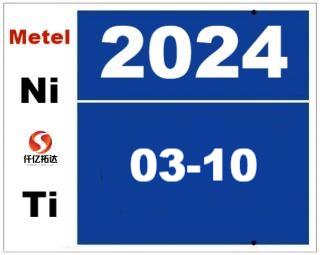ASME SB-863: Quality Assurance and Testing Requirements for Titanium Wires.
[ 信息发布:本站 | 时间:2024-03-13 | 浏览:553 ]
ASME SB-863: Quality Assurance and Testing Requirements for Titanium Wires.

ASME SB-863 is a standard specification issued by the American Society of Mechanical Engineers (ASME) that covers the requirements for seamless and welded titanium and titanium alloy tubes. It does not specifically address titanium wires. However, I can provide an overview of quality assurance and testing requirements typically associated with titanium wires, which may be relevant for manufacturers and users:
-
Material Selection and Composition: Manufacturers of titanium wires must ensure that the material used meets the required specifications, including chemical composition and purity. This involves sourcing titanium materials from reputable suppliers and verifying their compliance with applicable standards such as ASTM B863 for commercially pure titanium or ASTM B348 for titanium alloys.
-
Quality Control during Manufacturing: During the wire manufacturing process, quality control measures are implemented to ensure consistent quality and dimensional accuracy. This may include monitoring of process parameters such as temperature, pressure, and feed rates, as well as regular inspections of the wire for surface defects, dimensional deviations, and other quality issues.
-
Mechanical Testing: Titanium wires undergo mechanical testing to verify their tensile strength, yield strength, elongation, and other mechanical properties. Testing methods may include tensile testing, hardness testing, and bend testing, performed according to relevant ASTM or ASME standards.
-
Chemical Analysis: Chemical analysis is conducted to verify the composition of titanium wires, ensuring that they meet the specified requirements for elemental content and impurity levels. This is typically performed using techniques such as spectroscopy or elemental analysis.
-
Surface Inspection: Titanium wires are inspected for surface defects such as scratches, pits, or cracks, which could affect their performance or integrity. Visual inspection and non-destructive testing methods such as dye penetrant testing or eddy current testing may be employed for surface inspection.
-
Dimensional Inspection: Dimensional inspection is performed to ensure that titanium wires meet the specified dimensional tolerances for diameter, length, and straightness. This is typically carried out using precision measuring instruments such as calipers, micrometers, or laser measurement systems.
-
Traceability and Documentation: Manufacturers maintain traceability of titanium wires by documenting the manufacturing processes, material certifications, test results, and other relevant information. This ensures accountability and facilitates identification of the wire's origin and manufacturing history.
While ASME SB-863 specifically pertains to titanium tubes rather than wires, similar quality assurance principles and testing requirements apply to titanium wire manufacturing. Manufacturers and users of titanium wires should adhere to applicable industry standards and specifications to ensure product quality, reliability, and safety.
